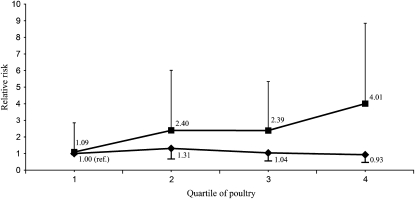FIGURE 1.
Relative risk of prostate cancer progression by prognostic risk and postdiagnostic consumption of poultry among 1294 men with prostate cancer in the Diet and Lifestyle substudy of CaPSURE (Cancer of the Prostate Strategic Urologic Research Endeavor, 2004–2008). P for interaction = 0.003 derived by using a Wald test of the coefficient of the cross-product term between poultry and prognostic risk in a Cox proportional hazards regression model adjusted for the main effects of poultry and prognostic risk (low/intermediate compared with high), age at diagnosis, energy intake, time from diagnosis to questionnaire, Gleason sum at diagnosis, prostate-specific antigen at diagnosis, primary treatment, BMI, and nonvigorous activity. ▪, high prognostic risk (prostate-specific antigen >20 ng/mL or Gleason sum = 8–10 or T stage T3a+); n = 200 participants (49 events). ♦ , low/intermediate prognostic risk; n = 1065 participants (73 events). Prognostic risk was missing for 29 participants (5 events).

